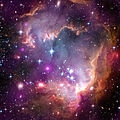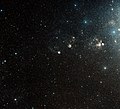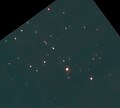| NGC 602 | |
|---|---|
 A Hubble Space Telescope (HST) image of NGC 602 (north is left). Sk 183 is just above centre, NGC 602a just below and left of centre, and NGC 602b towards the left edge. Credit: HST/NASA/ESA. | |
| Observation data (J2000 epoch) | |
| Right ascension | 01h 29m 32.133s[1] |
| Declination | −73° 33′ 38.13″[1] |
| Distance | 196 kly[2] (61 kpc[2]) |
| Apparent magnitude (V) | 15.44 (pg)[3] |
| Apparent dimensions (V) | 2.7'[4] |
| Physical characteristics | |
| Mass | - M☉ |
| Radius | 90 ly |
| Estimated age | 5 My[5] |
| - | |
| Other designations | N90[2] |
| Associations | |
| Constellation | Hydrus |
NGC 602 is a young, bright open cluster of stars located in the Small Magellanic Cloud (SMC), a satellite galaxy to the Milky Way. It was discovered on 1 August 1826 by Scottish astronomer James Dunlop.[6] It is embedded in a nebula known as N90.
Radiation and shock waves from the stars of NGC 602 have pushed away much of the lighter surrounding gas and dust that is N90, and this in turn has triggered new star formation in the ridges (or "elephant trunks") of the nebula. These even younger, pre-main sequence stars are still enshrouded in dust but are visible to the Spitzer Space Telescope at infrared wavelengths.[7] The cluster is of particular interest because it is located in the wing of the SMC leading to the Magellanic Bridge. Hence, while its chemical properties should be similar to those of the rest of the galaxy, it is relatively isolated and so easier to study.[8]
NGC 602 contains three main condensations of stars. The central core is NGC 602a, with the compact NGC 602b 100 arc-seconds to the NNW. NGC 602c is a looser grouping 11 arc-minutes to the NE, which includes the WO star AB8.[9]
NGC 602 includes many young O and B stars and young stellar objects, with few evolved stars.[10] Ionisation in the nebula is dominated by Sk 183, an extremely hot O3 main sequence star visible as the bright isolated star at the centre of the Hubble image.[11]
A number of other, more distant galaxies also appear in the background of the Hubble Space Telescope images of NGC 602, making for a "tantalizing"[12] and "grand"[13] view.
-
NGC 602 by the James Webb Space Telescope, 2024
-
Composite x-ray/optical/infrared image
-
NGC 602 region of the SMC
-
NGC 602c closeup
- ^ a b "NGC 602". SIMBAD. Centre de données astronomiques de Strasbourg. Retrieved 2013-04-04.
- ^ a b c "Hubble Observes Infant Stars in Nearby Galaxy". HubbleSite. Retrieved 2007-01-10.
- ^ Lindsay, E. M. (1961). "A new catalogue of emission-line stars and planetary nebulae in the Small Magellanic Cloud". Astronomical Journal. 66: 169. Bibcode:1961AJ.....66..169L. doi:10.1086/108396.
- ^ Westerlund, B. E. (1964). "The distribution of stars in the wing of the Small Magellanic Cloud-The region NGC 602". Monthly Notices of the Royal Astronomical Society. 127 (5): 429–448. Bibcode:1964MNRAS.127..429W. doi:10.1093/mnras/127.5.429.
- ^ Nemiroff, R.; Bonnell, J., eds. (10 January 2007). "NGC 602 and Beyond". Astronomy Picture of the Day. NASA. Retrieved 2007-01-10.
- ^ Seligman, Courtney. "New General Catalogue Objects: NGC 602". Celestial Atlas. Retrieved 29 August 2024.
- ^ "NGC 602: Ongoing Star Formation in a Young SMC Cluster". Hubble Heritage Project. January 2007. Retrieved 2007-02-09.
- ^ Carlson, L. R.; Sirianni, M.; Hora, J. L.; Sabbi, E.; Nota, A.; Meixner, M.; Clampin, M.; Gallagher, J.; Oey, M. S.; Pasquali, A.; Smith, L. J.; Tosi, M.; Walterbos, R. (2005). "Discovery of a Pre-main sequence Population in SMC cluster, NGC 602 with HST/ACS and SST/IRAC". Bulletin of the American Astronomical Society. 207: 1475, 185.03. Bibcode:2005AAS...20718503C.
- ^ Westerlund, B. E. (1964). "The distribution of stars in the wing of the Small Magellanic Cloud-The region NGC 602". Monthly Notices of the Royal Astronomical Society. 127 (5): 429–448. Bibcode:1964MNRAS.127..429W. doi:10.1093/mnras/127.5.429.
- ^ Gouliermis, Dimitrios A.; Schmeja, Stefan; Dolphin, Andrew E.; Gennaro, Mario; Tognelli, Emanuele; Prada Moroni, Pier Giorgio (2012). "The Clustered Nature of Star Formation. Pre-main-sequence Clusters in the Star-forming Region NGC 602/N90 in the Small Magellanic Cloud". The Astrophysical Journal. 748 (1): 64. arXiv:1201.3081. Bibcode:2012ApJ...748...64G. doi:10.1088/0004-637X/748/1/64. S2CID 119206857.
- ^ Evans, C. J.; Hainich, R.; Oskinova, L. M.; Gallagher, J. S.; Chu, Y.-H.; Gruendl, R. A.; Hamann, W.-R.; Hénault-Brunet, V.; Todt, H. (2012). "A Rare Early-type Star Revealed in the Wing of the Small Magellanic Cloud". The Astrophysical Journal. 753 (2): 173. arXiv:1205.2387. Bibcode:2012ApJ...753..173E. doi:10.1088/0004-637X/753/2/173. S2CID 119208446.
- ^ APOD: 2007 January 10 - NGC 602 and Beyond
- ^ "New Stars Shed Light On The Past". Science Daily. 2007-01-09. Retrieved 2007-02-09.



